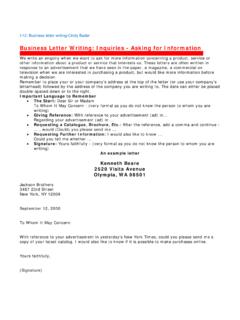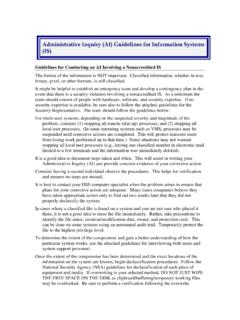Transcription of EVALUATION OF THE NZIRAMASANGA REPORT OF …
1 International Journal of Asian Social Science, 2013, 3(5):1077-1088 1077 EVALUATION OF THE NZIRAMASANGA REPORT OF INQUIRY INTO EDUCATION IN ZIMBABWE, 1999: THE CASE OF GENDER EQUITY IN EDUCATION Daniel Mawere Department of Gender Studies, Midlands State University ABSTRACT The paper evaluated recommendations of the NZIRAMASANGA REPORT as these recommendations relate to gender equity in education in Zimbabwe from 2000 to 2010. A desk review design, in which several documents were perused, was adopted for the study. A gender mainstreaming and empowerment framework built on three critical pillars, that is, parity, equity and equality was utilised. The successes of the REPORT s recommendations were based on the achievements of government and other gender equity stakeholders in formulating policies and strategies intended to bring about gender equity in the education sector.
2 In this EVALUATION process, the paper revealed that a number of successes have been realised. These include the National Gender Policy and its Implementation Strategy. An amendment to the Education Act in 2004 was made with a view to addressing and promoting gender equity in Education. Gender parity in primary schools has been achieved whilst in secondary schools it is about to be achieved. However, at tertiary level, gender disparities in enrolment are still a challenge. Feminisation of teacher education is now a reality as opportunities have been availed to female as well as male students to train as teachers. Engendering the curriculum is a process that has started. However teachers in the school system are not yet using gender responsive pedagogy, neither are textbooks used in schools all gender sensitive.
3 Policies such as those allowing maternity and paternity leave for girls who fall pregnant and boys, who are responsible for impregnating these girls respectively, though meeting with a lot of resistance, are also an example of an implementation success. However, the school and the community still require gender sensitisation to handle issues of girl pregnancies in a more humane way. Other challenges include religion and culture as inhibitive factors for the girl child and Affirmative Action Policies not being strictly followed up. By and large successes have been scored and challenges have been encountered in the implementation of gender equity recommendations. However, a lot more could be done by both government and other gender equity stakeholders to ensure that there is equal access of both males and females to educational facilities, resources and provisions that the country offers.
4 Key Words: EVALUATION , Gender Parity, Gender Equity, Gender Equality International Journal of Asian Social Science journal homepage: International Journal of Asian Social Science, 2013, 3(5):1077-1088 1078 INTRODUCTION Zimbabwe, as a member of regional and international committees has signed, ratified and acceded to several declarations, conventions and protocols targeted at creating an enabling environment for the attainment of gender equity and gender equality. The country s commitment to social justice therefore is evident in its signing, ratifying and acceding to the Convention on the Elimination of All Forms of Discrimination against Women, Beijing Declaration and Platform for Action and the Southern African Development Community s Declaration on Gender and Development.
5 Gender mainstreaming has become a strategy of the country to bring about gender equity and ultimately gender equality through education. To establish the extent to which the strategy is being implemented, an EVALUATION of the recommendations of the Presidential Commission of inquiry into Education and Training with specific reference to Gender Equity in Education forms the basis of this paper. Background and Purpose In January 1998, a 12 member committee under Chairperson Dr. Caiphas NZIRAMASANGA was appointed by the President of the Republic of Zimbabwe, to inquire into the country s entire education system. Term of reference of the enquiry mandated the Committee to address more specifically on specific areas in the education and training systems requiring reform on short-term, medium-term and long-term basis (Government of Zimbabwe, 1999).
6 A plethora of educational matters were explored in great detail culminating in a comprehensive 644- page REPORT published and presented to the President of the Republic of Zimbabwe in August 1999. The commission s REPORT contained findings, challenges and recommendations which were far reaching and were expected to guide educational reform at all levels into the new millennium for a considerable length of time. In view of this REPORT , this paper reviews a chapter in the NZIRAMASANGA REPORT , titled Gender Equity in Education (Chapter 9, pages 172 to 192). Term of reference of the enquiry mandated the committee To enquire into and REPORT on the issue of gender and gender equity as regards access to education at all levels and the formulation of appropriate remedial measures (Government of Zimbabwe, 1999).
7 The paper therefore, explores the implementation successes of the recommendations of the chapter on Gender and Equity in Education, challenges encountered in the implementation of the recommendations and opportunities that have availed themselves in the process. EVALUATION Methodology and Framework The EVALUATION of the NZIRAMASANGA Commission on gender equity in education was designed as a desk review, based on available information. A desk review is a review by the evaluator of the existing documentation related to the subject to be evaluated. Several documents were reviewed, covering the period between 2000 and 2010. Among the documents that were perused were: published and unpublished research reports, research articles on gender equity and gender equality, girls education and related issues.
8 Also perused were policy papers, government circulars and International Journal of Asian Social Science, 2013, 3(5):1077-1088 1079 guidelines. All the documents were reviewed through gender lenses. The documents included those that dealt specifically with gender parity and gender equity issues in education. The EVALUATION Framework The EVALUATION utilised a gender mainstreaming and empowerment framework. The framework is built on three critical pillars, that is, parity, equity and equality. Parity in education refers to equivalent percentages of women and men as well as girls and boys in an education system, relative to the population per age group. A focus on gender parity allows for identification of numerical gaps between women and men, boys and girls in terms of their participation in the education system, whether as students, teachers, lecturers or education leaders.
9 Gender parity allows for specificity and hard evidence on the extent of the gender equity problem. Parity is indicated by a gender parity index, which is a socio-economic index usually designed to measure the relative access to education of males and females. Gender parity index is calculated as the quotient of the number of females by the number of males enrolled in a given stage of education, be it primary, secondary or tertiary. Although a parity focus helps to describe the situation and highlight the gender equity problems, it does not necessarily contribute to the levelling of the education playing fields for women and men as well as girls and boys. In other words, parity is essential but is not sufficient for advancing gender equality (United Nations Girls Education Initiative, 2010).
10 To move towards gender equality application of the concept gender equity becomes important. Gender equity is the process of being fair to women and men as well as girls and boys. Gender equity denotes fairness of treatment of women and men, as well as girls and boys, according to their respective needs. It draws attention to the strategic actions, including policy and systemic actions that result in fair treatment of both females and males, in terms of realisation of their rights, access to benefits, obligations and opportunities. To ensure fairness, measures must be taken to compensate for historical and social disadvantages that prevent women as well as girls operating on a level education playing field with men and boys.











